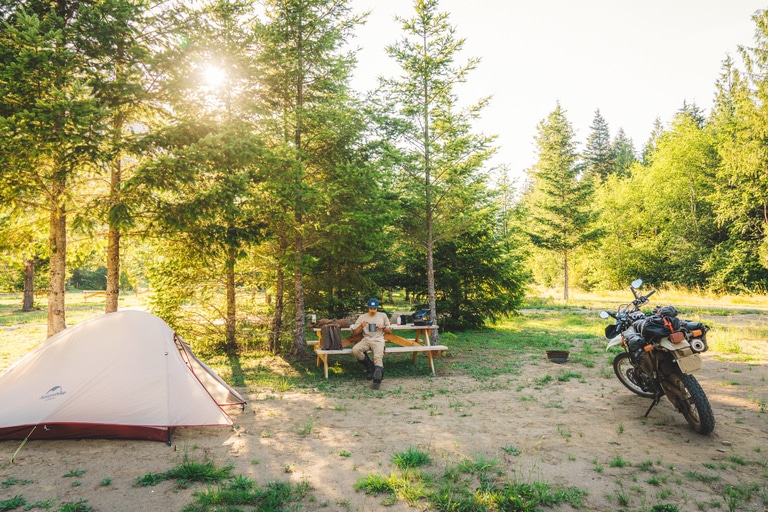Motocamping, a unique blend of motorcycle riding and camping, opens the door to exhilarating freedom and the opportunity to fully immerse yourself in the outdoors. After all, there’s no greater feeling than the wind whipping against your face with just you, your motorcycle and the journey ahead. If you already enjoy motorcycling and camping separately (or even bikepacking or backpacking), then you probably already have much of the gear you need to combine the two.
“When I first started riding a motorcycle, I knew [motocamping] was a subculture that was going to change my life,” says Jill Sandmire, a passionate motocamper and founder of Babes Moto Lounge, a Chicago-based womxn's motorcycle community. “Though, at that point, I had no idea just how much it would.”
In this guide, we glean insights from several motocamping experts about what motocamping is, where to do it and the gear you need to roll out.
Skip Ahead:
What is motocamping?
Simply put: Motocamping combines motorcycle riding and camping into one. Loved by motorcycle enthusiasts (or hopeful motorcyclists) and those who love to camp, the activity involves traveling by motorcycle to designated or dispersed campsites along a predetermined route.
Unlike car camping, where you have the luxury of filling up the your vehicle's trunk with gear, motocamping limits you to traveling with only what you can fit in a backpack or on the back of your bike. Lovers of the hobby pack and drive with all their gear— including tents, sleeping bags, sleeping pads, cookware and other essentials—on their motorcycle.
Who can motocamp?
“If you can ride a motorcycle, you can motocamp,” says Brian Jump, a longtime adventure motorcyclist and director of experiences, field services and operations at REI. “I started off the simple way, which was carrying as little as I could and going to easy-to-get-to camp spots with some level of infrastructure for comfort—and an easy way out.”
Because having access to a motorcycle is a prerequisite of motocamping, it’s easier for motorcyclists to adopt motocamping than those without a bike. But traditional campers, backpackers and bikepackers who have the desire to travel by two motorized wheels may want to add this hobby to their list. Motorcycle rentals and lessons are available—just make sure you take the proper safety precautions and know the risks before you commit. (Many state agencies, like the department of licensing, department of motor vehicles and department of public safety, list class resources. This will vary by state.) Motocamping can be physically and mentally challenging, and even grueling at times, depending on the weather, road conditions and difficulty of the route.
Additionally, you should have a solid foundation of motorcycle riding before embarking on a motocamping trip, Jump says.
"While there's no specific threshold of experience that applies to everyone, I typically recommend that individuals feel comfortable and confident in their riding abilities, especially when it comes to handling the added weight and balance challenges of carrying camping gear," he says.
Ultimately, Jump says the key is to prioritize safety and preparedness. "As riders gain experience and feel more at ease on their motorcycles, they can gradually tackle longer and more remote motocamping trips with greater confidence," he adds.
Where can I motocamp?
-nathaniel-stewart-2_web_xs.jpeg)
Where your motocamping adventures take you depends on your interests, type of bike, experience level and desired climate (as well as what kind of weather you’re willing to deal with). It also depends how far you want to travel and the mileage you’re comfortable riding in one day.
Places to Motocamp
Generally, motocampers set up camp at designated or dispersed sites at local state parks, national parks or national forests (rules may vary by park and state, so check local regulations). You can also motocamp at private campgrounds or on private land. Hipcamp is a great tool for finding and reserving private camp sites both nationally and internationally. (Here is a list of top Hipcamp motocamping spots to get you started) Just call ahead to make sure they can accommodate parking a motorcycle—or several, if you’re riding with others.
Related reading: Find Your Next Adventure with Hipcamp
Many state and national park campgrounds limit the number of motorcycles that can park near campsites, though this number varies from park to park. Make sure to check park regulations before booking your site. For traveling in more remote spots, like on land managed by the Bureau of Land Management, you’ll want to review off-road vehicle requirements to make sure your motorcycle is permitted on trails and roadways leading to your final destination. An important heads-up: Stick to designated roads, trails and off-road recreation areas when motocamping.
Planning Tips
First-time motocamper? Pick a close-to-home campground at a nearby state park. Want to ride over a long weekend? Reserve a regional campsite and bookmark nearby pit stops for easy day trips. If you’re aiming to go the distance, pick a route across state lines and piece together a longer-mileage road trip. Remember: You can also forgo camping altogether and “motoglamp” instead, renting accommodations like cabins or hotel stays along the way.
Related reading: What Is Glamping?
Weather plays a key factor in motocamping, and many riders stick to warmer seasons and destinations with more predictable climates (e.g., arid and warm). If you want to take advantage of warmer weather, consider options in the Southwest in the shoulder seasons and down South or along the California coast during winter.
Like a nonmotorized bike, the kind of motorcycle you plan to ride also determines where you can go. Some are built for long-distance travel on paved roads and remote trails (dirt, gravel and single-track). Others are great for beginners but may struggle to perform over long distances or off-road terrain. Consider which bike is best for your adventure and how far you plan to travel.
Motocamping trips can range from short overnights and weekend-long trips to extended journeys spanning weeks or months at a time. “My max would be 300 miles a day—that’s a really long day of riding,” says Sandmire. “My comfy zone is 200 miles as a more experienced rider, and I recommend only 150 miles or less at a time for beginner motocampers.”
What gear do I need for motocamping?

Like bikepacking, motocamping requires lightweight gear that you can fit in your pack or on your bike—in this case, a motorcycle. It’s also smart to carry waterproof gear in case it rains, even when traveling in arid climates.
Start with many of the same items you would bring on a bikepacking trip, including the Ten Essentials and additional safety items, like a helmet. Even though motocamping is a portmanteau of "motorcycle" and "camping," lightweight gear used for backpacking or bikepacking can be easier to travel with.
Related reading: Bikepacking Checklist
Gear Highlights:
Shelter: Depending on how much room you have in your pack or on your bike, you’ll want to bring a tent, tarp, bivy or hammock. If choosing a tent, consider a version designed for backpacking or bikepacking. These tend to be lighter and pack down smaller, making them easier to stash in saddle bags or a pack.
Sleep system: A sleeping pad or bag (or camp quilt) comprise your sleep system. Down sleeping bags or quilts designed for backpacking or bikepacking are ideal because they tend to be lighter and easier to compress.
Storage: Some motocampers add motorcycle-specific saddlebags to their rides to store gear. Depending on your needs, you may also want a pack (especially if you plan on lugging some gear from your bike to a campsite).
Hygiene: When you’re out in the elements all day, hygiene is a vital part of staying safe and sanitary on the road. Consider packing toiletries like biodegradable soap and a toothbrush and toothpaste in organizational containers, and bringing a compact, quick-drying camp towel.
First-aid: Bring along bandages, pain-relief pills, antiseptic creams and personal medications, among other items. Related reading: First-Aid Kit Checklist
Water: Stay hydrated while riding by stowing a hydration jug, canteen or a water bottle on your motorcycle (just make sure you can secure it without it leaking). Another option is to wear a hydration pack. If you’re taking an extended trip, make sure to plan pit stops in towns to replenish your water supply or bring a water filter/purifier (and check available water sources before you go).
Related reading: How to Choose a Water Filter or PurifierCookware: Pack lightweight kitchen supplies for cooking at the campground. Common items include a portable camp stove, fuel, pot or pan, and cooking utensils.
Tools: Always come prepared with the proper tools for fixing your motorcycle in an emergency.
Illumination: A headlamp or lantern is great for camp activities after dark. A headlamp can be especially helpful for emergency situations, like if you need to make bike repairs.
As for organizing and attaching your bags and equipment on your bike, gear straps and packing cubes come in handy. Many motorcycle brands also make saddle bags and luggage racks that fit and attach to the back and side of the bike.
Related articles:


